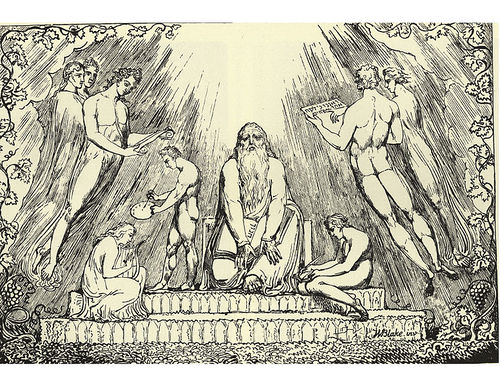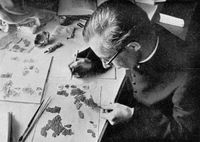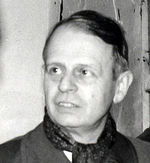Difference between revisions of "Category:Enochic Studies--1950s"
| (9 intermediate revisions by the same user not shown) | |||
| Line 4: | Line 4: | ||
{| cellpadding="2" cellspacing="5" style="width:100%; vertical-align:top; background:transparent;" | {| cellpadding="2" cellspacing="5" style="width:100%; vertical-align:top; background:transparent;" | ||
{{WindowMain | {{WindowMain | ||
|title= [[ | |title= [[Enochic Studies]] ([[1950s]]) | ||
|backgroundLogo= Bluebg_rounded_croped.png | |backgroundLogo= Bluebg_rounded_croped.png | ||
|logo= history.png | |logo= history.png | ||
|px= 38 | |px= 38 | ||
|content= [[File:Enoch Blake.jpg|500px]] | |||
The page: '''Enochic Studies--1950s''', includes (in chronological order) scholarly and literary works in the field of [[Enochic Studies]], made in the [[1950s]], or from 1950 to 1959. | |||
[[File:Milik2.jpg|thumb|200px|[[Józef T. Milik]]]] | |||
[[File:Andre Vaillant.jpg|thumb|150px|[[André Vaillant]]]] | |||
[[File:Erling Hammershaimb.jpg|thumb|150px|[[Erling Hammershaimb]]]] | |||
}} | }} | ||
{{WindowMain | {{WindowMain | ||
|title= [[ | |title= Highlights ([[1950s]]) | ||
|backgroundLogo= Bluebg_rounded_croped.png | |backgroundLogo= Bluebg_rounded_croped.png | ||
|logo = contents.png | |logo = contents.png | ||
|px= 38 | |px= 38 | ||
|content= | |content= | ||
* [[Dead Sea Scrolls Fragment of the Book of Enoch (1951 Milik), essay]] | |||
* [[Le livre des secrets d'Hènoch (1952 Vaillant), book]] | |||
* [[De gammeltestamentlige pseudepigrafer i oversaettelse (The Old Testament Pseudepigrapha in Translation / 1953-76 Hammershaimb), edited volume]] | |||
}} | }} | ||
{{WindowMain | {{WindowMain | ||
|title= | |title= [[Interpreters]] ([[1950s]]) | ||
|backgroundLogo= Bluebg_rounded_croped.png | |backgroundLogo= Bluebg_rounded_croped.png | ||
|logo = contents.png | |logo= contents.png | ||
|px= 38 | |px= 38 | ||
|content= | |content= | ||
}} | }} | ||
|} | |} | ||
|<!-- SPAZI TRA LE COLONNE --> style="border:5px solid transparent;" | | |<!-- SPAZI TRA LE COLONNE --> style="border:5px solid transparent;" | | ||
| Line 42: | Line 44: | ||
| style="width:35%; border:1px solid #a7d7f9; background:#f5faff; vertical-align:top; padding: 5px 10px 10px 8px; -moz-border-radius: 10px; -webkit-border-radius: 10px; border-radius:10px;"| | | style="width:35%; border:1px solid #a7d7f9; background:#f5faff; vertical-align:top; padding: 5px 10px 10px 8px; -moz-border-radius: 10px; -webkit-border-radius: 10px; border-radius:10px;"| | ||
{| id="mp-right" cellpadding="2" cellspacing="5" style="width:100%; vertical-align:top; background:#f5faff; background:transparent;" | {| id="mp-right" cellpadding="2" cellspacing="5" style="width:100%; vertical-align:top; background:#f5faff; background:transparent;" | ||
{{WindowMain | {{WindowMain | ||
|title= [[Timeline]] | |title= [[Timeline]] ([[1950s]]) | ||
|backgroundLogo= Bluebg_rounded_croped.png | |backgroundLogo= Bluebg_rounded_croped.png | ||
|logo= history.png | |logo= history.png | ||
|px= 38 | |px= 38 | ||
|content= | |content= [[File:1950s.jpg|thumb|left|250px]] | ||
'''''[[Enochic Studies]]''''' : [[:Category:Enochic Studies--2020s|2020s]] -- [[:Category:Enochic Studies--2010s|2010s]] -- [[:Category:Enochic Studies--2000s|2000s]] -- [[:Category:Enochic Studies--1990s|1990s]] -- [[:Category:Enochic Studies--1980s|1980s]] -- [[:Category:Enochic Studies--1970s|1970s]] -- [[:Category:Enochic Studies--1960s|1960s]] -- [[:Category:Enochic Studies--1950s|1950s]] -- [[:Category:Enochic Studies--1940s|1940s]] -- [[:Category:Enochic Studies--1930s|1930s]] -- [[:Category:Enochic Studies--1920s|1920s]] -- [[:Category:Enochic Studies--1910s|1910s]] -- [[:Category:Enochic Studies--1900s|1900s]] -- [[:Category:Enochic Studies--1850s|1850s]] -- [[:Category:Enochic Studies--1800s|1800s]] -- [[:Category:Enochic Studies--1700s|1700s]] -- [[:Category:Enochic Studies--1600s|1600s]] -- [[:Category:Enochic Studies--1500s|1500s]] -- [[:Category:Enochic Studies--1450s|1450s]] -- [[Enochic Studies|Home]] | |||
'''''[[Timeline]]''''' : [[2020s]] -- [[2010s]] -- [[2000s]] -- [[1990s]] -- [[1980s]] -- [[1970s]] -- [[1960s]] -- [[1950s]] -- [[1940s]] -- [[1930s]] -- [[1920s]] -- [[1910s]] -- [[1900s]] -- [[1850s]] -- [[1800s]] -- [[1700s]] -- [[1600s]] -- [[1500s]] -- [[1450s]] -- [[Medieval]] -- [[Timeline|Home]] | |||
}} | }} | ||
{{WindowMain | {{WindowMain | ||
|title= [[ | |title= [[Languages]] | ||
|backgroundLogo= Bluebg_rounded_croped.png | |backgroundLogo= Bluebg_rounded_croped.png | ||
|logo= contents.png | |logo= contents.png | ||
|px= 38 | |px= 38 | ||
|content | |content= [[File:Languages.jpg|thumb|left|250px]] | ||
'''[[Enochic Studies]]''' : [[:Category:Enochic Studies--English|English]] -- [[:Category:Enochic Studies--French|French]] -- [[:Category:Enochic Studies--German|German]] -- [[:Category:Enochic Studies--Italian|Italian]] -- [[:Category:Enochic Studies--Latin|Latin]] -- [[:Category:Enochic Studies--Spanish|Spanish]] -/- [[Enochic Studies|Other]] | |||
}} | }} | ||
|} | |||
|} | |||
== History of Research ([[1950s]]) -- Notes == | |||
In 1951 a dramatic announcement shook the world of Enochic Studies. Józef T. Milik confirmed the presence at Qumran of Aramaic fragments from all Enoch booklets except the Parables. The rediscovery of significant portions of the original text was the beginning of a new chapter in the history of research even though in the immediate it resulted into a major setback. Twenty-five years would pass from that dramatic announcement to the actual publication of the Aramaic Enoch fragments. For all those years, 1 Enoch was in limbo. A few new translations appeared in the 1950s, one in Danish (1956), and two in Hebrew (1956, 1958). Waiting for the actual publication of the Aramaic texts was necessary—it was simply a matter of good sense. | |||
On the other hand, the study of 2 Enoch had a major development with the publication in 1952 of the edition by Vaillant. | |||
In popular culture, ancient esoteric traditions about the existence of a primeval (Enochic) wisdom were combined with the new "science" of ufology reviving the genre of "Fantastic Archaeology" and pushing it to unprecedented levels of popularity. | |||
Latest revision as of 14:17, 19 December 2019
|
|
Enochic Studies : 2020s -- 2010s -- 2000s -- 1990s -- 1980s -- 1970s -- 1960s -- 1950s -- 1940s -- 1930s -- 1920s -- 1910s -- 1900s -- 1850s -- 1800s -- 1700s -- 1600s -- 1500s -- 1450s -- Home Timeline : 2020s -- 2010s -- 2000s -- 1990s -- 1980s -- 1970s -- 1960s -- 1950s -- 1940s -- 1930s -- 1920s -- 1910s -- 1900s -- 1850s -- 1800s -- 1700s -- 1600s -- 1500s -- 1450s -- Medieval -- Home
|
History of Research (1950s) -- Notes
In 1951 a dramatic announcement shook the world of Enochic Studies. Józef T. Milik confirmed the presence at Qumran of Aramaic fragments from all Enoch booklets except the Parables. The rediscovery of significant portions of the original text was the beginning of a new chapter in the history of research even though in the immediate it resulted into a major setback. Twenty-five years would pass from that dramatic announcement to the actual publication of the Aramaic Enoch fragments. For all those years, 1 Enoch was in limbo. A few new translations appeared in the 1950s, one in Danish (1956), and two in Hebrew (1956, 1958). Waiting for the actual publication of the Aramaic texts was necessary—it was simply a matter of good sense.
On the other hand, the study of 2 Enoch had a major development with the publication in 1952 of the edition by Vaillant.
In popular culture, ancient esoteric traditions about the existence of a primeval (Enochic) wisdom were combined with the new "science" of ufology reviving the genre of "Fantastic Archaeology" and pushing it to unprecedented levels of popularity.
Pages in category "Enochic Studies--1950s"
The following 11 pages are in this category, out of 11 total.
1
- Dead Sea Scrolls Fragment of the Book of Enoch (1951 Milik), essay
- Le livre des secrets d'Hènoch (1952 Vaillant), book
- De gammeltestamentlige pseudepigrafer i oversaettelse (The Old Testament Pseudepigrapha in Translation / 1953-76 Hammershaimb), edited volume
- Henoch im jüdischen Gebet und in jüdischer Kunst (1959 Peterson), essay
~
- The Eschatology of the Similitudes of Enoch (1952 Black), essay
- Recherches de syntaxe sur le texte éthiopien d'Énoch (1952 Caquot), essay
- La recompense de los justos immediate a su muerte en IV Macabeos y en las parábolos de Enoc (1955 Vilar Hueso), essay
- L'eschatologie des Esséniens et le livre d'Hénoch (1958 Grelot), essay
- La géographie mythique d'Hénoch et ses sources orientales (1958 Grelot), essay
Media in category "Enochic Studies--1950s"
This category contains only the following file.
- 1956 Jessup (arch-fi).jpg 344 × 500; 57 KB






